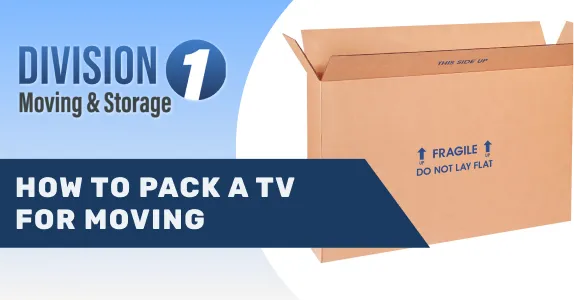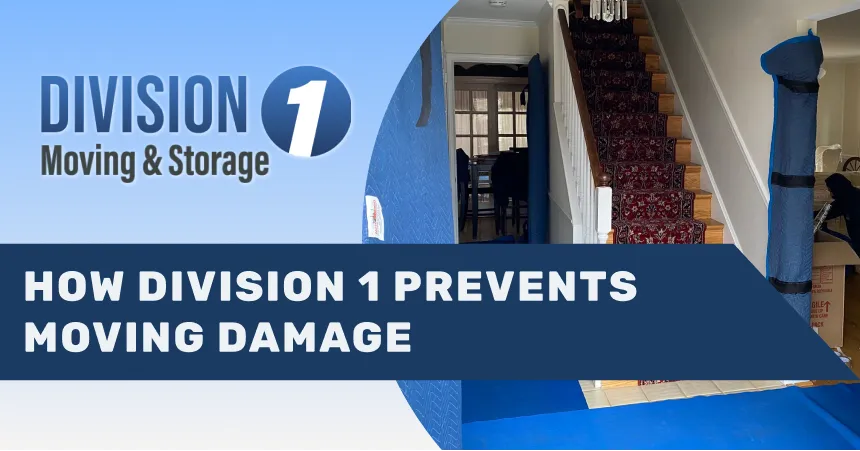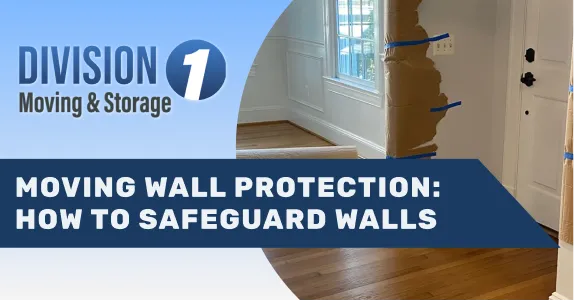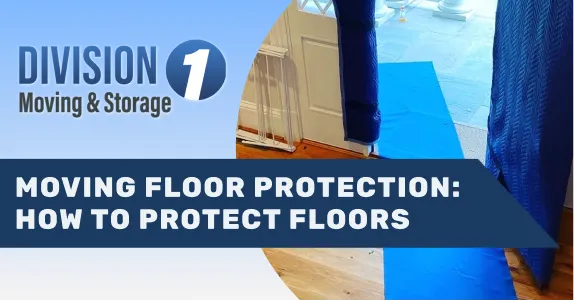Our lives are intricately woven with electronic marvels, from sleek flat-screen TVs to the pulsating heart of our gaming consoles and the silent efficiency of our computers. The prospect of moving to a new abode brims with excitement, but when it comes to packing these prized technological treasures, a wave of apprehension can wash over us.
Let’s discover the art of securely and efficiently packing electronics for a seamless move. This guide is your compass through this labyrinthine journey, ensuring that your cherished electronics arrive at their new haven in flawless condition.
But here's the twist—the journey doesn't have to be a solitary one. Enter Division 1 Moving and Storage, your trusted partner in this odyssey of safeguarding your electronic gems. As you dive into the depths of electronic packing wisdom, we're here to illuminate the way. Our expertise is not just in moving; it's in the meticulous care and protection of your electronics, those treasures that hold both monetary and sentimental value.
Join us on this journey as we unravel the secrets of electronic packing, hand in hand with the experts at Division 1 Moving and Storage. Together, we'll ensure the safe passage of your electronic companions to their new home, where they'll continue to enhance your life in your fresh surroundings.
Understanding the Importance of Proper Packing

In the hustle and bustle of relocating, it's easy to overlook the nuances of packing, especially when it comes to our prized electronics. These devices, which often hold both monetary and sentimental value, deserve special attention. Let's delve into why it's paramount to pack them with utmost care.
Protection from Damage: Electronics are delicate and can easily get damaged if not packed correctly.
Cost-Efficiency: Proper packing can save you from the expensive ordeal of replacing or repairing damaged items.
Ease of Unpacking: Organized packing means easier and quicker unpacking at your new place.
Preservation of Data: Incorrect packing can lead to data loss, especially in storage devices like hard drives.
Environmental Concerns: Proper packing reduces the risk of harmful substances from damaged electronics polluting the environment.
Peace of Mind: Knowing your electronics are safely packed alleviates stress during the moving process.
Categorizing Your Electronics

Our homes and offices brim with a diverse range of electronic devices. Each type, based on its size and functionality, demands a unique packing approach. Before embarking on the packing journey, it's important to categorize your electronics. This not only streamlines the process but also ensures that each device gets the specialized care it deserves.
Large Electronics
While the trend in technology leans towards compactness, large electronics such as televisions, desktop computers, and sound systems remain staples in many homes. Their size and significance make them particularly vulnerable during moves. The distress of discovering a damaged screen or component after relocation highlights the critical need for meticulous, upright packing to protect these valuable items.
Medium Electronics
Medium electronics like laptops, gaming consoles, and printers hold crucial data and memories. Consider the potential loss of vital documents from a jolted laptop during transit. Such scenarios emphasize the importance of protective packing for these devices.
Small Electronics
Small electronics, such as tablets, smartphones, and digital cameras, are integral to our daily lives. Recalling the anxiety of a momentarily misplaced smartphone underscores the need to securely store these devices during a move, ensuring they're easily reachable amidst the relocation chaos.
Essential Packing Materials

The success of any move, especially when it involves delicate items like electronics, hinges not just on the techniques employed but also on the materials used. Just as a craftsman is only as good as his tools, the safety of your electronics is largely dependent on the quality and appropriateness of your packing materials. Let's delve into the indispensable items you'll need to ensure your electronics are packed securely.
- Moving Boxes: It's advisable to have a collection of boxes in various sizes.
- Bubble Wrap: Its cushioning properties make it ideal for wrapping around your devices, offering a protective layer that guards against shocks and impacts.
- Packing Peanuts: These small, foam nuggets act as a buffer, preventing unwanted movement of the items inside and providing an additional layer of cushioning.
- Packing Paper or Newspaper: Packing paper or newspaper can be gently wrapped around screens to offer protection without risking scratches.
- Scissors: These are essential tools for cutting packing materials to size, opening packages, and other miscellaneous tasks during the packing and moving process.
- Twist Ties: Twist ties are perfect for bundling wires and cords together, ensuring they remain organized and don't become a tangled mess.
- Protective Plastic or Trash Bags: Using protective plastic or even trash bags to cover your devices can shield them from dust and other particulates.
- Strong Packing Tape: Strong packing tape is essential for securely sealing your boxes, ensuring they stay closed and the contents remain protected.
- Markers: Clearly marking each box with its contents and handling instructions, like "Fragile" or "This Side Up," can guide movers and make the unpacking process much more straightforward.
4-Step Guide to Packing Electronics for Moving
In the digital age, safeguarding electronics during relocation is crucial. Our 4-step guide is meticulously designed to ensure the safe and efficient packing of these valuable items. By following this, you'll not only protect your devices but also ensure their longevity and immediate usability at your new destination.

Step 1: Preparation and Consultation
As you approach your moving day, it's crucial to begin the packing process in a well-lit, clutter-free environment, such as a spacious table or desk. This initial phase is all about laying the groundwork for the safe transportation of your electronics. Let’s review key actions to ensure each device is prepped and ready for the move, taking into account their unique requirements and vulnerabilities.
User Manuals: Always start by consulting the user manuals of your electronic devices. They often contain specific packing guidelines tailored for the device.
Cooling Period: Unplug your devices and let them sit for at least 24 hours. This ensures they are at room temperature, reducing the risk of internal condensation which can cause damage.
Battery Removal: Take out batteries from devices to prevent leakage. Store them separately in labeled zip-lock bags so you can easily locate them later.
Backup Data: Ensure you backup essential data as a safety measure against unforeseen mishaps.
Cleaning: Gently clean your electronics to eliminate dust and prevent scratches during transit.
Step 2: Organize and Bundle
Once you've prepared your electronics, the next phase focuses on the meticulous organization of cords and accessories. In a designated workspace, take the time to detach, bundle, and label each cord. Proper organization now will save you hours of untangling and confusion later, ensuring a smoother setup at your new destination. Let's delve into the key actions for this step:
Detaching Cords: Disconnect all cords and cables from your devices to prevent potential damage during the move.
Bundling: Neatly secure each cord using twist ties or rubber bands, preventing tangles and knots.
Labeling: Use colored stickers or tags to label each cord and its corresponding device, facilitating easier reconnection later.
Accessory Storage: For smaller accessories like USB drives or earbuds, consider using small containers or pouches. This keeps them safe and easily accessible.
Photograph Setup: Before dismantling, take photos of your electronics setup. This provides a visual reference for reassembly and connection in your new location.
Step 3: Secure Packing
After organizing your electronics and their accessories, the next pivotal step is ensuring they're packed securely for transit. In a spacious area, gather your packing materials and begin the process of wrapping and boxing each item. The goal is to minimize movement and potential damage, ensuring your electronics arrive in the same condition they were packed. Here are the essential actions to consider for this phase:
- Original Packaging: Whenever possible, use the device's original boxes. These are specifically designed to offer the best protection.
- Bubble Wrap: In the absence of original packaging, rely on bubble wrap as a protective barrier against shocks and scratches.
- Fillers: After placing devices in boxes, use packing peanuts or crumpled newspaper to fill gaps, ensuring stability during movement.
- Accessories: Pack items with detachable parts or smaller accessories separately. For example, individual wrapping for printer cartridges can prevent potential leakage. Store accessories like earbuds in zip-lock bags within the main device's box.
- Sealing: Securely tape all box openings, reinforcing corners and edges. This extra step prevents accidental openings and adds an additional layer of protection.
Step 4: Ready to Move
As the final step in your packing journey, ensuring your boxes are clearly labeled and ready for transport is paramount. In a well-lit area, review each packed box, adding labels and handling instructions. Proper labeling not only aids in the unpacking process but also provides movers with essential information to handle your electronics with care. Here's what to focus on as you finalize your packing:
- Detailed Labeling: Mark each box with a clear description of its contents, specifying the type of device inside, such as "Laptop" or "Digital Camera."
- Handling Instructions: Essential labels like "FRAGILE," "HANDLE WITH CARE," and "THIS SIDE UP" guide movers on the care required for each box.
- Inventory List: Consider creating a quick inventory list of boxes and their contents. This can be a helpful reference during unpacking or in case you need to locate a specific item quickly.
- Weather Protection: If you anticipate moving in rainy or snowy conditions, wrap boxes in plastic or use waterproof markers. This extra layer ensures labels remain legible and boxes stay dry.
Special Considerations for Long-Distance Moves
Embarking on a long-distance move brings with it a unique set of challenges, especially when it comes to safeguarding your electronics. The extended transit times, varying environmental conditions, and potential for mishaps mean that your devices need extra attention and care. When moving across states or even countries, it's essential to factor in some additional considerations to ensure your electronics arrive in pristine condition.
Climate Control: Prolonged exposure to extreme cold or heat can damage electronic internal components. Ensure that your electronics are transported in vehicles with climate control, especially if you're moving through regions with significant temperature variations.
Insurance: Consider investing in insurance specifically for your valuable electronics. This provides peace of mind, knowing that even in the unfortunate event of damage or loss, you're covered.
Inventory List: Create a detailed inventory list of all your electronics. This not only helps in keeping track but also in setting up once you reach your destination.
Anti-Static Bags: For devices like computers, consider using anti-static bags for components like hard drives. These bags prevent static electricity, which can be harmful to electronic components.
Professional Packing Service: If you're unsure about packing your electronics safely for a long journey, consider hiring a professional packing service. They have the expertise and materials to ensure your items are packed securely.
By taking these special considerations into account, you can navigate the complexities of a long-distance move with confidence, ensuring your electronics reach their new home safely.
Choosing Division 1 Moving Services for Your Electronic Packing Needs
When it comes to packing electronics for a move, entrusting the task to professionals can make all the difference. At Division 1 Moving and Storage, we offer a wide range of packing services tailored to meet your specific needs, ensuring that your electronics are protected throughout the journey to your new destination.

Expertise and Experience
With decades of experience in the logistics industry, our team possesses the knowledge and expertise needed to pack your electronics securely. We understand the unique requirements of different devices and can provide specialized packing solutions.
High-Quality Materials
We use top-quality packing materials, including bubble wrap, packing peanuts, and sturdy boxes, to ensure maximum protection for your electronics. Our commitment to quality extends to every step of the packing process.
Safety First
At Division 1, safety is our priority. We take every precaution to prevent damage during transit. From careful organization to secure labeling, your electronics are in safe hands.
Convenience
Moving can be a stressful process, but with our packing services, you can focus on other aspects of your move while we handle the intricate task of packing your electronics.
Comprehensive Services
Whether you're moving locally or embarking on a long-distance journey, our packing services are designed to cater to your needs. We offer solutions for all types of electronics and can adapt to the specific requirements of your move.
Customer Satisfaction
Our track record of satisfied customers speaks for itself. We are dedicated to ensuring that your electronics arrive at your new home in pristine condition, providing you with peace of mind throughout the moving process.
Full-Service Solutions
Beyond packing, Division 1 Moving and Storage offers a range of services, including long-distance moving, warehouse storage, junk removal, and more. We are your one-stop solution for all your moving needs.
Why Choose Division 1 Moving and Storage?
In our tech-centric world, safely packing electronics for a move is essential. This guide has outlined the key principles of organization, choosing the right packing materials, and careful handling to ensure your valuable devices arrive at their new destination intact.
But you don't have to face this task alone. Division 1 Moving and Storage is your trusted partner in safeguarding your electronics during a move. We understand the significance of these devices, both in terms of their monetary value and the memories they hold. Our experienced team specializes in electronic packing, employing top-quality materials and expert techniques to ensure their safety during transit.
Don't let the stress of packing electronics overwhelm you. Contact Division 1 Moving and Storage today to learn more about our packing services and how we can tailor a solution to your unique needs. We're here to make your move stress-free, ensuring the safe arrival of your electronics and peace of mind for you and your family.
Don't delay; reach out to Division 1 Moving and Storage for a quote today and embark on your journey to a new home with confidence.
%201.webp)

.webp)





























.webp)


